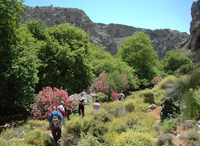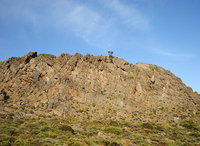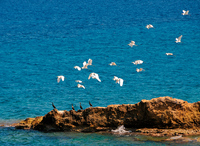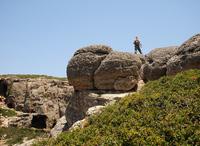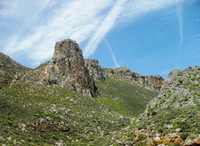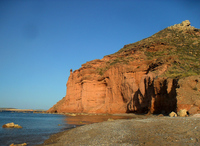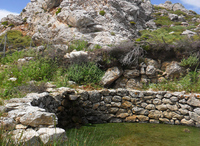The nature of Sitia district remains rich and virgin.
- There are many expanded candidate "NATURA areas"
- Numerous sites of exceptional natural beauty
- Rare geological forms and sights of geological development
- Ten (10) large gorges and geological crevices
- Three hundred (300) caves of great interest
- Two thousand one hundred (2100) species of self-sown plants, 300 are endemic and there are many aromatic or medicinal plants
- A great number of rare animal and bird species. Her you can find the biggest colony in the world of the Eleanor's falcon (FALCO DE ELEONORA).
- The richest and purest sea biotope in the Aegean (Northern of Psiros island) where even corals grow.
- Wide meadows with the protected seaweed kind "Poseidonia"
- The unique in Europe Palm tree forest of Vai
- The beginning of the European path E4
- Many biotopes of mixed Euro-African vegetation (in Vai, Koufonisi etc.)
According to the ecology professor of the Crete University Mr. Mylonas: "A natural environment one of its kind in Greece and in Europe is of course a very rare if not unique natural and aesthetic Jewel"
A trip in Sitia, therefore , in a land of unprecedented contradictions and dazzling beauty the predominant impression is that of a nature which is marked by all those features that human intelligence and sensuality should long for and the artistic expression should imitate.
Yet the traveler, who wishes to get acquainted to real Crete in depth, should look for the everlasting roots of the people and the exceptional human attitude that survived in Sitia due to the generosity of the stunning nature, its geographical seclusion and self-sufficiency.
Vai: the most important palm tree forest in Europe
A beautiful sandy beach surrounded by the palm tree forest, situated in a valley next to the ancient city of of Itanos. It is 28 km away from Sitia, 8 km from Palekastro and 6km from the monastery "Toplou".
It covers 200 hectares and it consists of agrestal Phoenix Theofrasti palm trees. It is a unique in size forest, not only in Greece but also in Europe.
Except in the beach of Vai, this type of palm tree is also found in units or clusters in other parts of Crete (Preveli, Aghios Nikitas, ect), in other islands of the north-east Aegean, in Cyprus and Turkey.
There are many legends around the origin of the palm tree forest. It is said that it was created by the Phoenicians who, according to a theory, first inhabited the area of Itanos. According to other legends, the palm tree was created by the seeds of dates consumed by the Epyptian soldiers of Ptolemeos or of the King of Pontus, Mithridatis, who in the framework of alliances had settled in the area, or by Saracen pirates. Whatever the cause of its creation, the sure thing is that the palm tree forest of Vai is preserved by the dry and warm climate, as well as the underground water of the valley. Palm trees existed in Crete since antiquity, according to the testimonies of Theofrastos and Plinios and considering their representation on coins and vessels. Clusters of palm trees are also found at the beach of Itanos. Apart from palm trees, other kinds of African vegetation grow in the area, making it a place of unique biodiversity.
The area is also a passage of migrating birds. The landscape is adorned with the pale lines on the horizon, the harmonious interchange of hills and lowlands, the vineyards and the olive plantations, the exotic colors and the dazzling light, while the existence of ancient cities and the "Toplou" monastery assign a unique historical and cultural importance to the region. Due to its unique value and beauty, Vai is protected by the Greek state, the European community and by international conventions.





